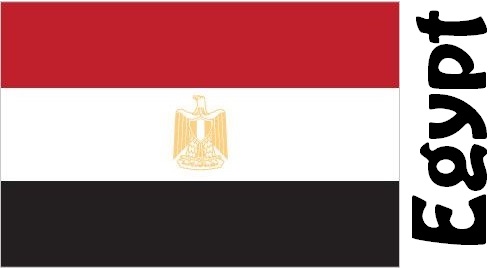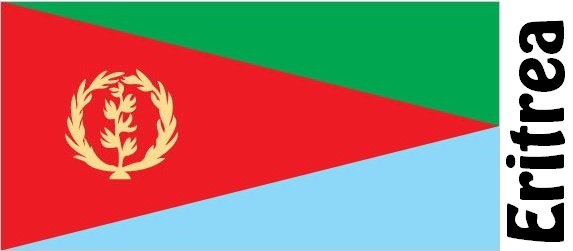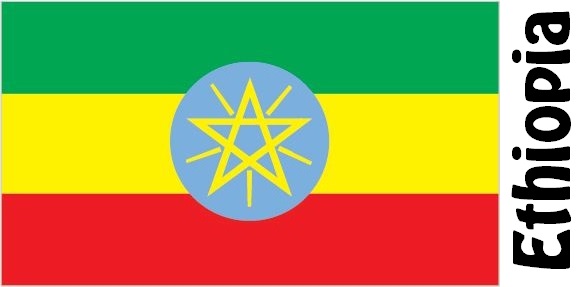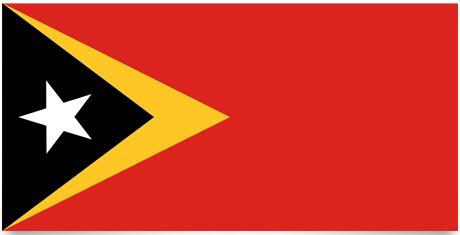Flags of Countries that Start with E
How many countries beginning with E? There are a total of 7 countries starting with letter E among the 193 countries in the world:
- Ecuador
- Egypt
- El Salvador
- Equatorial Guinea
- Eritrea
- Estonia
- Ethiopia
Estonia

Estonia is a republic in northern Europe on the Baltic Sea and the Gulf of Finland. The country is the northernmost of the three Baltic countries and includes the islands of Saaremaa (Øsel), Hiiumaa (Dagø) and Muhu. The landscape is mostly flat or hilly lowland with plains. There are many peat bogs, large forest areas, streams and several large lakes.
There is temperate coastal climate in V and temperate mainland climate in the island.
The country’s most important natural resources are oil shale and forest. The slate is used, among other things. for electricity generation, and Estonia is self-sufficient in electricity. In particular, furniture, wood, paper and cellulose, as well as textiles, chemicals and machinery are exported.
From 1940 to 1991, Estonia was a Soviet republic and Estonia still holds a large Russian minority. Today, Estonia is a member of both NATO and the EU.
Country Facts – State Capital – Population Graph – Airports – Public Holidays – Embassies of Estonia – Embassies in Estonia – Import Regulations – Major Trade Partners – Major Imports – Major Exports
El Salvador

El Salvador is a republic in Central America. Country borders to Guatemala and Honduras. The landscape consists of a narrow coastal plain with lagoons and mangrove swamps in the S as well as two parallel mountain ranges in the direction E-V. The mountain ranges contain several active volcanoes. Between the two mountain ranges are fertile highlands, lakes and rivers.
The climate is tropical on the coast and slightly cooler in the highlands. Frequent devastating earthquakes occur.
Agriculture is the most important profession. Coffee, cotton and sugar are mainly grown for export. The country in particular gets energy from hydropower.
El Salvador was ravaged by civil war in the period 1980-1992. There are still large socio-economic differences in the country.
Country Facts – State Capital – Population Graph – Airports – Public Holidays – Embassies of El Salvador – Embassies in El Salvador – Import Regulations – Major Trade Partners – Major Imports – Major Exports
Ecuador

Ecuador is a republic in the northwest of South America. The country is off to the Pacific Ocean with borders to Peru and Colombia. Andean mountains form two parallel mountain ranges with a central high plain between. In the island the lowlands are covered by dense rainforest. IV is the most forested lowland. Ecuador also includes the Galápog Islands.
The climate is tropical in the low parts of the country, temperate in the highlands and polar with glaciers on the snow-covered volcanoes.
The most important natural resources are oil, natural gas, gold, timber and hydropower. In addition to oil, especially bananas and shrimp are exported. Agriculture employs almost 1/3 of the workforce.
Despite the country’s oil reserves, Ecuador is one of the poorest countries in South America.
Country Facts – State Capital – Population Graph – Airports – Public Holidays – Embassies of Ecuador – Embassies in Ecuador – Import Regulations – Major Trade Partners – Major Imports – Major Exports
Egypt

Egypt is a republic in North Africa. The country is located on the Mediterranean and the Red Sea. The Libyan Desert V of the Nile is a flat desert with oases. The Arabian Desert between the Nile and the Red Sea consists mainly of mountains and plateaus. The Sinai Peninsula is the most flat sand desert, however highlands and mountains in S.
Egypt has a subtropical climate.
Egypt’s most important natural resources are oil and natural gas. Agriculture employs almost 1/3 of the workforce. The Nile Valley and the Nile Delta are fertile areas. Irrigation is necessary in most places. Cotton, sugar cane and wheat are mainly grown. Tourism is also an important profession.
In 2011, great political turmoil and massive demonstrations occurred in Egypt. This led to more shifts in power and political instability. In 2014, the military ousted the government and since then a new civilian regime has been introduced.
Country Facts – State Capital – Population Graph – Airports – Public Holidays – Embassies of Egypt – Embassies in Egypt – Import Regulations – Major Trade Partners – Major Imports – Major Exports
Eritrea

Eritrea is a republic in North Africa by the Red Sea. The northern and central parts of Eritrea consist of a fertile highland. IS there is desert. The country includes several small islands and coral reefs off the narrow coastline.
The climate is tropical, extremely hot and dry. The rainfall is very irregular and extremely low in SV.
Over 3/4 of the working population is engaged in agriculture. The drought is very devastating to agriculture and thus the economy. Salt is extracted in the coastal areas.
Eritrea was previously an Italian, later British colony until 1951, when the country became part of Ethiopia. Eritrea became independent in 1993. There are border disputes between Eritrea and Ethiopia. Eritrea is one of the poorest countries in the world.
Country Facts – State Capital – Population Graph – Airports – Public Holidays – Embassies of Eritrea – Embassies in Eritrea – Import Regulations
Ethiopia

The Republic of Ethiopia is a hinterland state in NE Africa. Ethiopia lies on a plateau for approx. 2,000 meters height divided by a large burial ground with salt lakes and springs. The Blue Nile originates in Ethiopia. The highlands are covered with sawdust and tropical forest. In NV there are fertile lowlands with large rivers. In the island there is desert.
The climate is tropical with long periods of drought. However, more temperate in the highlands.
Agriculture is the most important profession. Coffee, cotton, sugar and other foods are mainly grown. Ethiopia has significant deposits of gold, salt, platinum and potassium salts. Ethiopia in particular gets energy from hydropower.
Ethiopia has never been colonized. There have been disputes with Eritrea over the border between the states for several years.
Country Facts – State Capital – Population Graph – Airports – Public Holidays – Embassies of Ethiopia – Embassies in Ethiopia – Import Regulations – Major Trade Partners – Major Imports – Major Exports
Equatorial Guinea

Equatorial Guinea is a republic in V-Africa. The country also includes the two mountainous islands of Bioko and Pagalu. Equatorial Guinea faces the Gulf of Guinea and borders Gabon and Cameroon.
The climate is tropical and rainy.
The population lives mainly on fishing, forestry or agriculture. Cattle are kept and grown among other things cocoa, coffee, cassava, cassava and sweet potatoes. Oil is the country’s most important export product and exports have created economic growth in the country. Lumber and cocoa are also important export goods.
Equatorial Guinea was formerly a Spanish colony. Independent in 1968. Equatorial Guinea is characterized by political instability and a large part of the population has fled the country.
Country Facts – State Capital – Population Graph – Airports – Public Holidays – Embassies of Equatorial Guinea – Embassies in Equatorial Guinea – Import Regulations – Major Imports – Major Exports
East Timor

East Timor (Timor-Leste) is a republic in SE Asia. The northeastern part of the island of Timor belongs to East Timor and the western part belongs to Indonesia. The landscape is predominantly mountainous. Towards S there is lowland with mangrove forest and savanna.
The climate is tropical and warm. There is dry season from March to November.
A large part of the population lives by self-sufficiency farming. The main crops are rice, maize and sweet potatoes as well as copra, coffee, rubber, wax and saddle wood for export. There are large oil reserves in the Timor Sea between East Timor and Australia.
East Timor was a Portuguese colony until 1975, after which the country was annexed by Indonesia. This led to a bloody civil war that lasted until 1999. East Timor became independent in 2002.

Country Facts – State Capital – Population Graph – Airports – Public Holidays – Import Regulations













































